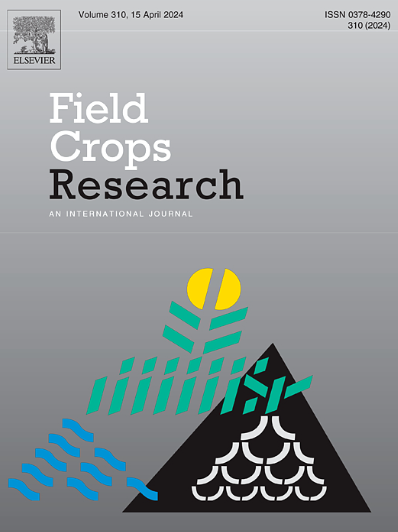生物固氮和鸽豆产量:生物炭和保护性农业在低投入系统中的作用
IF 5.6
1区 农林科学
Q1 AGRONOMY
引用次数: 0
摘要
在玉米优势种植系统中,豇豆等豆科植物的生物固氮是一种潜在的重要氮输入和补充土壤氮的途径。生物炭已被报道影响氮循环,但在撒哈拉以南非洲低投入系统中,关于保护性农业(CA)和生物炭改良对鸽豆生物固氮的协同作用的研究尚未见报道。本研究的目的是研究CA系统下生物炭改性对生物固氮的影响,因为这些做法在SSA中是有希望的可持续强化选择。具体而言,我们在乌干达不同农业生态区的三个地点探讨了CA条件下鸽豆轮作和生物炭改良对(1)生物固氮和(2)鸽豆籽粒产量的影响。我们假设在CA下施用生物炭比单独CA或常规耕作具有更高的生物固氮和粮食产量。材料与方法我们设置了三个站内实验;一个在乌干达中部(Mubende区),两个在乌干达北部(Alebtong和Gulu区),为期两个季节。CA涉及最少的耕作,通过手工锄地建立种植盆地。我们研究了四种处理(1)常规轮作耕作(conventional),(2)轮作最少耕作(CA),(3)第一年和第二年施用CA和2 Mg ha−1生物炭(CA+BC+BC),(4)第一年施用一次CA和4 Mg ha−1生物炭(CA+BC)。结果与阿勒布通和穆本德相比,古鲁地区的生物固氮性较高;与其他地点相比,这主要与土壤氮含量低和来自大气氮的百分比(%Ndfa)较高有关。不同季节处理对生物固氮的影响不同,2022年albtong和Mubende在CA系统中施用生物炭对生物固氮没有影响。2023年,CA系统中生物炭的添加显著增加了所有站点的生物固氮。在所有季节和地点,与常规做法相比,在CA系统中施用生物炭显著提高了粮食产量。单次施用或分次施用4mg ha−1生物炭对生物固氮和粮食产量的影响相似。结论在CA系统下,生物炭对生物固氮有积极影响。在古鲁地区,生物固氮相关的额外氮素输入高达106 kg N ha - 1,显著提高了粮食产量。一次性施用4 Mg ha−1的生物炭与第1年施用2 Mg ha−1,第2年施用2 Mg ha−1的生物炭无显著差异。本文章由计算机程序翻译,如有差异,请以英文原文为准。
Biological N2-fixation and grain yield of pigeon pea: The role of biochar and conservation agriculture in low-input systems
Context
Biological N2-fixation by legumes such as pigeon pea is a potentially important nitrogen input and a pathway for replenishing soil nitrogen (N) in maize dominant cropping systems. Biochar has been reported to affect N cycling, yet there are no studies on the synergism of conservation agriculture (CA) and biochar amendments on biological N2-fixation of pigeon pea in low input systems of sub-Saharan Africa.
Objectives
The objective of this study was to investigate the effect of biochar amendments under CA systems on biological N2-fixation, as these practices are promising sustainable intensification options in SSA. Specifically, we explored the effects of pigeon pea rotation and biochar amendments under CA on (1) biological N2-fixation, and (2) pigeon pea grain yield at three sites located in different agro-ecological regions of Uganda. We hypothesized that application of biochar under CA leads to greater biological N2-fixation and grain yield, than CA alone or conventional tillage.
Materials and methods
We set up three on-station experiments; one in Central Uganda (Mubende district), and two in Northern Uganda (Alebtong and Gulu districts) for two seasons. CA involved minimum tillage with planting basins established by hand hoeing. We investigated four treatments (1) conventional tillage with crop rotation (Conventional), (2) minimum tillage with crop rotation (CA), (3) CA and 2 Mg ha−1 of biochar, applied in both first and second year (CA+BC+BC), and (4) CA and 4 Mg ha−1 of biochar, applied once in the first year (CA+BC).
Results
Biological N2-fixation was high in Gulu, compared to Alebtong and Mubende; and this was mainly related to low soil N and greater percent of N derived from the atmosphere (%Ndfa), compared to other sites. Treatment effect on biological N2-fixation was variable across seasons, biochar application in CA systems did not affect biological N2-fixation in 2022 in Alebtong and Mubende. In 2023, biochar amendments in CA systems significantly increased biological N2-fixation in all sites. Grain yield was significantly increased by biochar application in CA systems compared to conventional practices, in all seasons and sites. A single dose application or split application of 4 Mg ha−1 biochar had similar effects on biological N2-fixation and grain yield.
Conclusions
Biological N2-fixation was positively influenced by biochar application under CA systems. The additional N input associated with biological N2-fixation was up to 106 kg N ha−1 in Gulu and it significantly increased grain yield. There were no differences between once off application of 4 Mg ha−1 of biochar or applying 2 Mg ha−1 in the first year followed by 2 Mg ha−1 in the second year.
求助全文
通过发布文献求助,成功后即可免费获取论文全文。
去求助
来源期刊

Field Crops Research
农林科学-农艺学
CiteScore
9.60
自引率
12.10%
发文量
307
审稿时长
46 days
期刊介绍:
Field Crops Research is an international journal publishing scientific articles on:
√ experimental and modelling research at field, farm and landscape levels
on temperate and tropical crops and cropping systems,
with a focus on crop ecology and physiology, agronomy, and plant genetics and breeding.
 求助内容:
求助内容: 应助结果提醒方式:
应助结果提醒方式:


